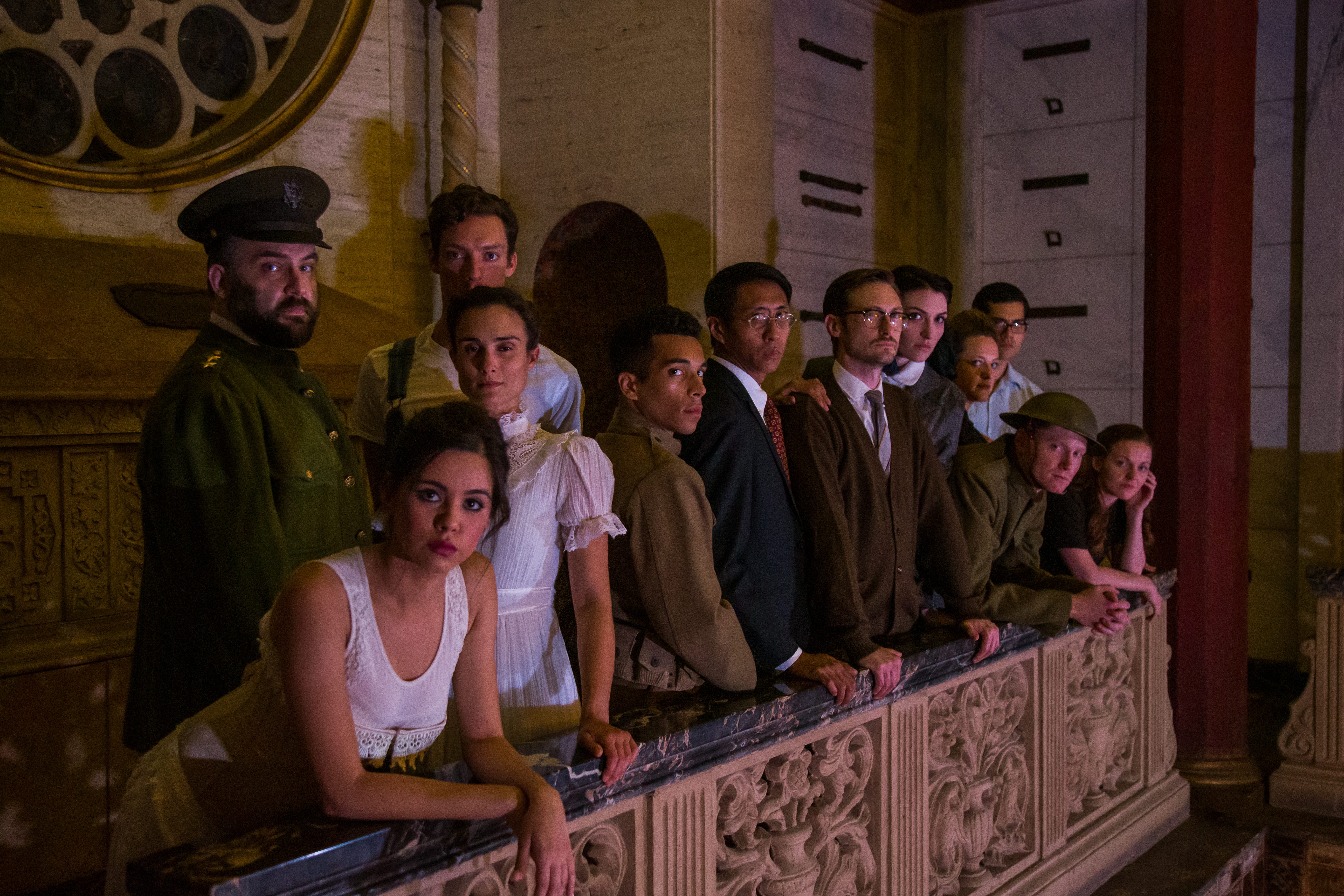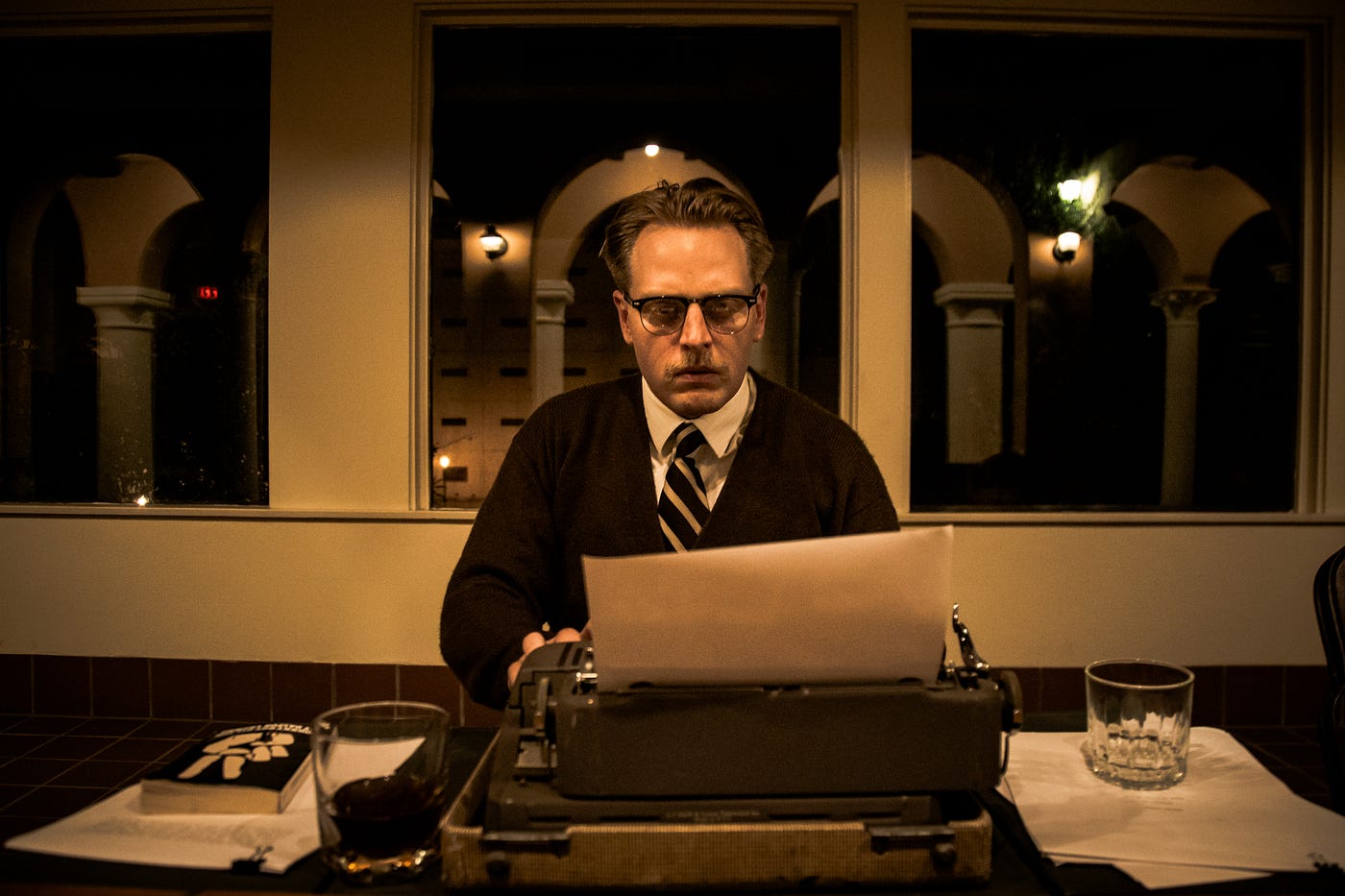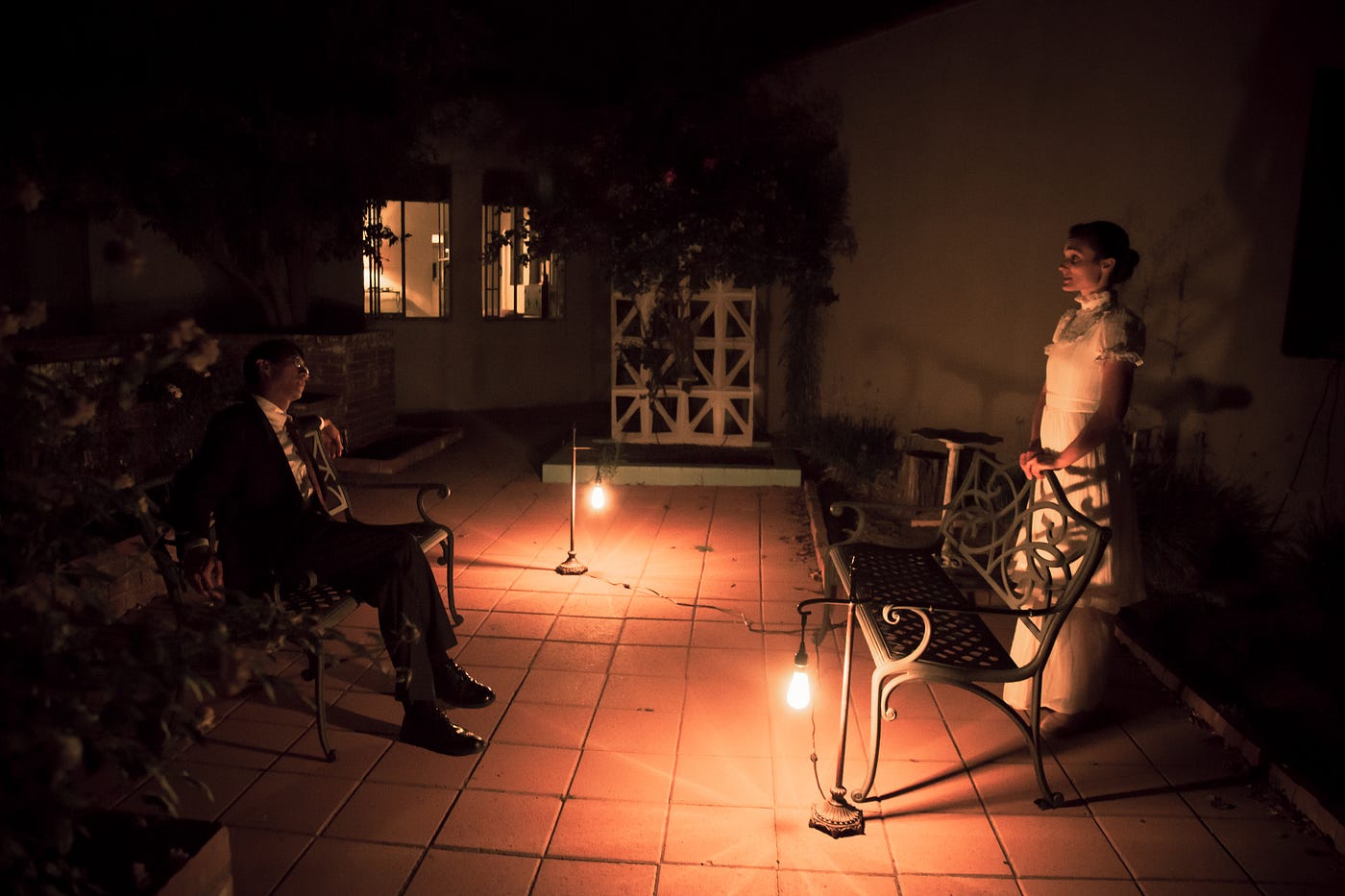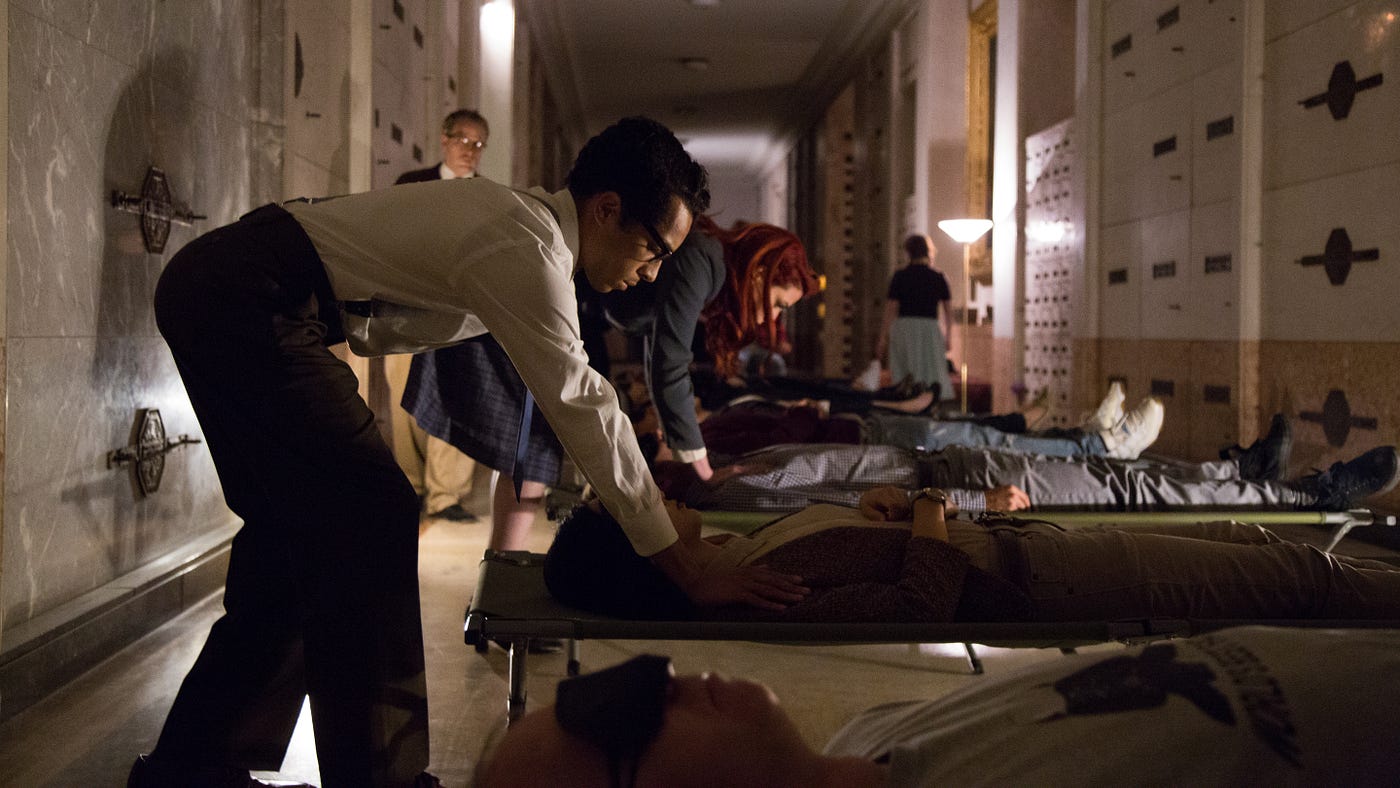
(The following contains minor spoilers.)
“Johnny, what do you want?”
“What do you want, Johnny?”
“What do you want?”
This same question is repeated over and over.
But we, the audience, have no answer. What Johnny wants is irrelevant.
Johnny will live forever, whether he wants to or not.
Johnny lives on. All time is all time.
And we are all Johnny.

The Johnny Cycle is a sprawling production by LA’s The Speakeasy Society; a re-imagining and fusing together of three previous immersive productions — The Quick and the Dead (2015), The Shell (2016), and The Living (2017) — all drawing upon the same source material: Dalton Trumbo’s Johnny Got His Gun. This version marries all three chapters, covering both the life of screenwriter/novelist and accused Communist Trumbo as well as the fictional story of Johnny, the protagonist of Trumbo’s novel.
Johnny Got His Gun, published in 1939, tells the story of Joe Bonham (aka Johnny), a young soldier during WWI who loses his arms, legs, and all of his face including his eyes and mouth, after an artillery shell explodes. When he wakes up in the hospital, Johnny is unable to communicate with the outside world. His mind functions perfectly and Johnny struggles to remain sane, treading the line between fantasy and reality, as he narrates the novel. But in The Johnny Cycle, that’s just the first layer of the conceptual onion. The author himself, his wife, his daughter, his friend Robert Rich, and various figures from Trumbo’s life co-exist within Johnny’s mind, as do Johnny’s best friend, his girlfriend, his mother, his father, and more, including people who he’s never actually spoken to or met. And, then, there’s us.
Here the audience is cast as “Johnny.” That is, the entire audience claims the role of a single character, as opposed to playing versions of themselves within a fictional world or taking on the role of specific characters within the narrative. It’s a bold, fairly advanced choice to put the whole of the audience at the center as a single character. It’s certainly an unusual design decision I’ve not encountered before in my years covering East Coast immersive. And it’s a decision which sometimes presents issues during this already complex, intensely layered dark ride. The witty, outspoken Trumbo (Matthew Bamberg-Johnson) asks, “Johnny, what are you doing here?” He addresses the crowd in surprise, almost as if he wasn’t expecting us to be here. A concerned nurse (Bianca Ruiz-Brokcl) stares into my eyes and asks me, “Johnny, do you know what day it is?” as she holds my hand. And “Follow me, Johnny,” is the command when it’s time to go into another room.
Each person can even respond to the characters as Johnny; performers point at or gesture towards specific audience members with directives like “Tell her you won’t leave,” or “Shout, ‘I’m still here!’” or “Say, ‘I’ll support you.’” And, as obedient audience members, we recite the phrases given to us at the appropriate cues, rarely going off-script. It is strongly implied that you must follow their directions precisely; the action can’t move forward without the next line and the cast and rest of the audience wait for you to say your line each time.
Get Kathryn Yu’s stories in your inbox
Join Medium for free to get updates from this writer.
SubscribeSubscribe
This repeat-after-me technique is one of The Speakeasy Society’s signature moves. They call it “you say…” prompting: in order to cue the audience member “who” they are and what is supposed to happen next, the performers quite literally tell them what to say. But this method of interacting seems somewhat at odds with casting the entire audience as Johnny. If indeed we are all “Johnny” and the form that The Johnny Cycle takes is an interior, emotional journey throughout the recesses of Johnny’s mind, then why do the other characters explicitly feed us lines throughout the experience? Shouldn’t the audience be able to respond authentically as Johnny to the situations unfolding around them, many of which seem to come from Johnny’s memories? Is Johnny so far gone that he doesn’t remember what he did or said when revisiting the past? If we are truly Johnny, then why do we need additional prompting?

The seams of this “you say…” technique are much less noticeable in the smaller, intimate scenes. For example, Johnny’s last night as a civilian is spent with the luminous, still-frozen-at-age-ninteen Kareen (played by a tender Haylee Nichele). Each of the five of us in the room took turns having a goodbye conversation with Kareen, as easily cued by a fellow soldier (A’raelle Flynn-Bolden). But there are a few moments during the production where the audience unfortunately reverts to watching the play instead of inhabiting it. The cumulative effect of “you say…” pulling the audience out of the fiction is more evident in the large scale gatherings, such as when the audience stands on the ground floor looking up to the balcony and the cast loom above us shouting instructions rapid fire. Multiple “you say…”s coming down from above in succession feels like the cracking of suspension of disbelief, without completely breaking it.
One of the cardinal sins of immersive theatre is to make the audience feel like they aren’t “in” on the joke. I’ve seen other productions where plot twists spring out of nowhere or a performer reveals some hidden fact that my character “should” have known already, but that important information was withheld. To be clear: The Johnny Cycle never makes the audience feel foolish or embarrassed. In fact, the execution of the “you say…” technique stands out less in the heat of the moment than it does upon reflection days after the fact. Because we all get fed lines in one way or another, the individual members of the audience are less put on the spot that it might come across in this review, but to be a voyeur observing in silence is not possible in The Johnny Cycle. Audience participation is required for the show to move forward and it can be a bit awkward at times if the crowd tends towards the quieter end of the spectrum. More timid attendees might also balk at what is being asked of them, particularly if it involves Trumbo defending himself in front of the House Un-American Activities Committee where the judge, witnesses, and jury are played by the audience.
Some of the show’s self-contradicting logic could be chalked up to Johnny’s state of mind post-injury. Trapped in his limbless body, without the benefits of sight, hearing, or speech, Johnny’s head begins unravel with the passage of time. Interestingly enough, the audience can still see, speak, and walk as we become Johnny, with the exception of one scene when the audience is blindfolded and asked to lie on a hospital cot. We as “Johnny” go limp as voices move around us in the darkness and unseen hands press against our foreheads or gently move our still extant limbs around. During this scene, I begin to understand how trapped Johnny feels. But physically I still embody the Johnny of the past; I have arms and legs because, presumably, that’s how Johnny continues to view his own body in his mind.

So: perhaps the experience of The Johnny Cycle ought not adhere so strictly to such various world-building rules. After all, we are physically traversing a hypnotic fever dream where we live through not just Johnny’s memories but also Trumbo’s memories — which happen years in the future. These include things that Johnny could not have possibly been privy to, events pulled from real-life history and woven into the overarching narrative. We see the lead up to Trumbo’s testimony as an accused Communist in front of Congress and evidence of Trumbo’s strained relationship with his wife and daughter. Within this world, characters like Trumbo also know that they’re dead and when they died and how they died; we know this because they tell us this. Scenes jump around in time, with characters implying that today is Johnny’s birthday or perhaps the Fourth of July or maybe Christmas, and then the following dialogue immediately casts doubt as to which day it really is. Meanwhile, the inside of Johnny’s mind is like a pinball machine where the same ideas bounce endlessly from lever to lever, never finding a resting spot. All time is all time.
And we experience not just the events of Johnny’s (fictional) life and Trumbo’s (real) life, but also come into contact with other living memories who transform from human beings into walking, talking personifications of ideas, taking on the personas of argued perspectives. They wail and shout about the futility of politics, the value of free speech, the real cost of war, and if it’s all really worth it in the end. The Johnny Cycle transports us to a strange, circular place that exists outside of space and outside of time in order to interrogate the impact of war. The internal rules of this story world contradict one another or are broken just as quickly as they are made. At times the show feels like a bubble within a bubble within a bubble, being self-referential to the n-th degree. This is a play written about a man born out of a book written by a different man, after all. (The Speakeasy Society does not lack for ambition, to be sure.) None of this is real but it’s all real in Johnny’s mind and thusly in our minds.
The dream-like Johnny Cycle experience is transportive in other ways as well. The stunning Mountain View Mausoleum lends a considerable emotional heft to the already memorable show. I notice snippets of dialogue echoing down endless white marble hallways, each tile on the wall inscribed with the names of the dead from long ago. Somewhere in the distance, someone chants “1, 2, 3, 4, clickety-clack, clickety-clack,” in military time. At the end of a dark hallway sits a rotary phone, placed ominously on a pedestal, lit by a spotlight from above. I stumble upon a broken soldier (James Cowan) sitting on the floor muttering to himself, illuminated only by the soft warm glow of a lantern at his feet. Dare I intrude on his introspection? I come across an empty chair, with the jewel tones of a stained glass window shining brightly in the background. These tableaux linger now even if I shut my eyes.
Some of the most striking moments of The Johnny Cycle also come from an unexpected source, the movement-based scenes. I am transfixed by cast members swaying in unison through the pews of a church, or coming together silently clutching lanterns in the darkness, or assembling in a line and falling one by one, executed by an imaginary rifle. And the wonders of the visuals are accentuated further with exquisite sound design, be it the murmurs of a party coming from the room next door, the ragged breathing of a hospital patient, or the lonely echo of a telephone ringing and ringing with no end.
I think to myself: Hell is empty, but all the devils are here, in this Mausoleum, walking among the living.
During a scene in the mural gallery — the crown jewel of the building’s architecture — I find myself surrounded by oil painting after oil painting. I crane my neck to take in the 180-foot long display but I can not see it all at once. It is surely impossible to do so. I wonder how many dead surround me on these hallowed grounds. Far too many to count. And in the center of the long hallway, under the domed ceiling I see painted two words, each in opposition to one another: “meditation” and “memories.”
Two simple words that contain multitudes, that contain all Johnny has left, all Johnny can do now, all Johnny can cling to in the world, as his mind continues to go around and around in circles for all eternity.
All time is all time.
Johnny lives on.
We are all Johnny.
The Johnny Cycle plays August 22 — September 21 at the Mountain View Mausoleum in Altadena, California. Tickets are $125.
NoPro is a labor of love made possible by our generous Patreon backers. Join them today!
In addition to the No Proscenium web site, our podcast, and our newsletters, you can find NoPro on Twitter, Facebook, YouTube, Instagram, in the Facebook community Everything Immersive, and on our Slack forum.
Office facilities provided by Thymele Arts, in Los Angeles, CA.



















Discussion